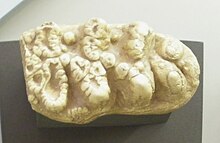| Choerolophodon Temporal range: Miocene, 19–5.3 Ma PreꞒ Ꞓ O S D C P T J K Pg N | |
|---|---|

| |
| Skull | |
| Scientific classification | |
| Kingdom: | Animalia |
| Phylum: | Chordata |
| Class: | Mammalia |
| Order: | Proboscidea |
| Family: | †Choerolophodontidae |
| Genus: | †Choerolophodon Schlesinger, 1917 |
| Species | |
| Synonyms | |
| |
Choerolophodon is an extinct genus of proboscidean that lived during the Miocene of Eurasia and Africa. Fossils of Choerolophodon have been found in Africa, Southeast Europe, Turkey, Iraq, Iran, the Indian subcontinent, and China.
Description
The tusks growing from the upper jaw are long and strongly curved, with one large mostly complete tusk from the Chalkidiki Peninsula of Greece having a total length of around 2.5 metres (8.2 ft), with a likely total weight when complete of around 70 kilograms (150 lb). The molar teeth are trilophodont and bunodont. The half-lophids are chevroned. The accessory conules are multiplied (choerodont), and the enamel is corrugated (ptychodont). The lower jaw has an unusual combination of being long, but lacking tusks/incisors, a trait only shared among proboscideans with the North American gomphothere genera Eubelodon and Gnathabelodon. It has been suggested that instead of teeth, the end of the lower jaw housed a keratinous cutting blade.
Taxonomy

Numerous species of Choerolophodon are known: C. pentelicus, C. anatolicus and C. chioticus from Southeast Europe (Turkey (Yamula Dam in Kayseri), Greece, Bulgaria) and the Middle East, C. palaeindicus and C. corrugatus from the Indian subcontinent, C. guangheensis from China, and C. ngorora and C. zaltaniensis from Africa. The name Choerolophodon was erected for "Mastodon" pentelicus from Greece by Schlesinger (1917) based on the discovery of new material from the pentelicus type locality. A 2022 study considered Choerolophodon to be a basal member of Elephantida, with Amebelodontidae and Gomphotheriidae more closely related to each other than either is to Choerolophodon.
Ecology
Dental microwear analysis of specimens from Greece suggest that these individuals were grazers, while mesowear analysis of specimens from East Africa suggest varying browsing and grazing-dominated mixed feeding diets, depending on locality.
Evolution
The genus is first known during the Early Miocene in Africa and South Asia. They subsequently dispersed across Asia and into southeast Europe. The genus became extinct at the end of the Miocene.

References
- Chunxiao Li, Shi-Qi Wang, Dimila Mothé & Xijun Ni (2019) New fossils of early and middle Miocene Choerolophodon from northern China reveal a Holarctic distribution of Choerolophodontidae, Journal of Vertebrate Paleontology, DOI: 10.1080/02724634.2019.1618864
- Sankhyan, Anek R. and Chavasseau, Olivier. 2018. New proboscidean fossils from Middle Siwaliks of Haritalyangar area, Himachal Pradesh, India. Palaeontologia Electronica 21.1.15A 1-12. https://doi.org/10.26879/844 palaeo-electronica.org/content/2018/2200-haritalyangar-proboscideans
- Wang, S.; Deng, T. (2011). "The first Choerolophodon (Proboscidea, Gomphotheriidae) skull from China". Science China Earth Sciences. 54 (9): 1326. Bibcode:2011ScChD..54.1326W. doi:10.1007/s11430-011-4201-6. S2CID 131674259.
- "Tek parça halinde ve 7.5 milyon yıllık! Kayseri'de bulundu - Habertürk". Haberturk.com (in Turkish). Habertürk. 28 August 2019. Retrieved 9 September 2019.
- Konidaris, George E.; Koufos, George D. (2013) . "Late Miocene Proboscidea (Mammalia) from Macedonia and Samos Island, Greece: preliminary results". Paläontologische Zeitschrift. 87 (1): 121–140. Bibcode:2013PalZ...87..121K. doi:10.1007/s12542-012-0147-z. ISSN 0031-0220. S2CID 128764592.
- Larramendi, Asier (2023-12-10). "Estimating tusk masses in proboscideans: a comprehensive analysis and predictive model". Historical Biology: 1–14. doi:10.1080/08912963.2023.2286272. ISSN 0891-2963.
- ^ Konidaris, George E.; Tsoukala, Evangelia (2022), Vlachos, Evangelos (ed.), "The Fossil Record of the Neogene Proboscidea (Mammalia) in Greece", Fossil Vertebrates of Greece Vol. 1, Cham: Springer International Publishing, pp. 299–344, doi:10.1007/978-3-030-68398-6_12, ISBN 978-3-030-68397-9, S2CID 245023119, retrieved 2023-03-25
- Mothé, Dimila; Ferretti, Marco P.; Avilla, Leonardo S. (12 January 2016). "The Dance of Tusks: Rediscovery of Lower Incisors in the Pan-American Proboscidean Cuvieronius hyodon Revises Incisor Evolution in Elephantimorpha". PLOS ONE. 11 (1): e0147009. Bibcode:2016PLoSO..1147009M. doi:10.1371/journal.pone.0147009. PMC 4710528. PMID 26756209.
- Li, Chunxiao; Deng, Tao; Wang, Yang; Sun, Fajun; Wolff, Burt; Jiangzuo, Qigao; Ma, Jiao; Xing, Luda; Fu, Jiao (2023-08-16). Longer mandible or nose? Co-evolution of feeding organs in early elephantiforms (Report). Paleontology. doi:10.1101/2023.08.15.553347.
- ^ George E. Konidaris, George D. Koufos, Dimitris S. Kostopoulos & Gildas Merceron (2016) Taxonomy, biostratigraphy and palaeoecology of Choerolophodon (Proboscidea, Mammalia) in the Miocene of SE Europe-SW Asia: implications for phylogeny and biogeography, Journal of Systematic Palaeontology, 14:1, 1-27, DOI: 10.1080/14772019.2014.985339
- Schlesinger, G., 1917. Die Mastodonten des K. K. Naturhistorischen Hofmuseums. Denkschriften des K. K. Naturhistorischen Hofmuseums 1:1-230.
- Baleka, Sina; Varela, Luciano; Tambusso, P. Sebastián; Paijmans, Johanna L.A.; Mothé, Dimila; Stafford, Thomas W.; Fariña, Richard A.; Hofreiter, Michael (January 2022). "Revisiting proboscidean phylogeny and evolution through total evidence and palaeogenetic analyses including Notiomastodon ancient DNA". iScience. 25 (1): 103559. Bibcode:2022iSci...25j3559B. doi:10.1016/j.isci.2021.103559. PMC 8693454. PMID 34988402.
- Saarinen, Juha; Lister, Adrian M. (2023-08-14). "Fluctuating climate and dietary innovation drove ratcheted evolution of proboscidean dental traits". Nature Ecology & Evolution. 7 (9): 1490–1502. Bibcode:2023NatEE...7.1490S. doi:10.1038/s41559-023-02151-4. ISSN 2397-334X. PMC 10482678. PMID 37580434.
| Genera of the order Proboscidea | ||||||||||||||||||||||||||||||
|---|---|---|---|---|---|---|---|---|---|---|---|---|---|---|---|---|---|---|---|---|---|---|---|---|---|---|---|---|---|---|
| ||||||||||||||||||||||||||||||
| 
 | |||||||||||||||||||||||||||||
| Taxon identifiers | |
|---|---|
| Choerolophodon | |
